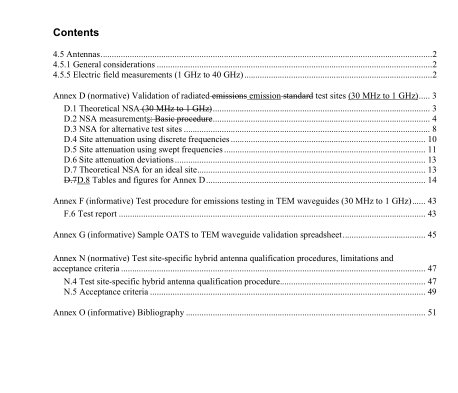IEEE C63.4A-2017 pdf download.American National Standard for Methods of Measurement of Radio- Noise Emissions from Low-Voltage Electrical and Electronic Equipment in the Range of 9 kHz to 40 GHz Amendment 1: Test Site Validation
NOTE 1—For both the discrete frequency and the swept frequency methods, an impedance mismatch at the output of the signal source or at the input of the EMI receiver or spectrum analyzer may result in cable reflections that could cause errors exceeding the NSA tolerance. This can be avoided by use of padding attenuators of 10 dB, i.e., one at the output end of each transmitting and receiving cable antenna end of the transmit antenna cable and one at the receiver end of the receive antenna cable, for both V Direct and V Site measurements. Attenuator values of 6 dB are often adequate, and values as low as 3 dB can sometimes be used.
NOTE 2—For vertically polarized antennas, it is especially important to maintain cables leaving the antennas in the same horizontal plane as the center of the antenna directly behind the antenna for a minimum distance of 1 m. Use of ferrite beads on both the transmit antenna and the receive antenna cables close to the antennas can help to eliminate common-mode signals that can contribute to measurement errors.
D.2.4 Single-position NSA measurements for standard test sites A standard test site 30 shall be validated by measuring NSA with the transmit antenna and the receive antenna separated by the measurement distance, for both horizontal and vertical antenna polarizations, for a single location of the antenna pair above the reference ground plane. Basic setups are shown in Figure D.1 and Figure D.2 (see D.8), for horizontal polarization and vertical polarization of the antenna pair, respectively. The test site shall be evaluated in the exact measurement geometry (i.e., locations of transmit antenna and receive antenna on the site) that is used for subsequent product testing. The transmit antenna shall be placed at the EUT location used during subsequent radiated emission measurements (e.g., at the center of the turntable), while the receive antenna shall be positioned at a location that is separated from the transmit antenna location by the measurement distance; see also the site descriptions in 5.4.1, and the site layout in Figure 5 of 5.7 (both in ANSI C63.4-2014). The transmit antenna and the receive antenna shall be placed in the same polarization, and oriented towards each other. Antenna heights above the ground plane per polarization and antenna type for single-position NSA standard test site validation are as shown in Table D.2.
D.2.5 Site acceptability criterion A test site is considered suitable for performing radiated emission measurements in 30 MHz to 1 GHz if the results of all NSA measurements described in this annex meet the requirements of 5.4.4.2, and the reference ground plane of the test site complies with the requirements of 5.4.3 (subclause numbers are per ANSI C63.4-2014).
D.3 NSA for alternative test sites D.3.1 General For an alternative test site (test site that has only one conducting surface, i.e., the horizontal floor of the facility (for example, a weather-protected OATS or a semi-anechoic chamber; see other descriptions in 5.4.2 of ANSI C63.4-2014), a single-position NSA measurement (i.e., per D.2.4) is insufficient to pick up possible reflections from the construction or materials or the RF-absorbing materials comprising covering the walls and ceiling of the test site, or weather-protection coverings for an OATS. For a weather-protected OATS, it shall be confirmed that the weather-protection covering structure does not influence emission measurements.A weather-protected OATS, regardless whether the weather- protection structure covers only a portion of (e.g., the turntable area) or the entire OATS, is not considered a standard test site, because the potential effects of the covering structure cannot be determined without performing volumetric NSA measurements.
Therefore, each weather-protected OATS shall be validated using the positions and geometries described in D.3.3 and D.3.4. Different from the single-position NSA measurements used for a standard test site of (i.e., site as described in 5.4.1 of ANSI C63.4-2014; see also D.2.4), alternative test sites require a multi-position NSA measurement, as follows: NSA measurements made with the transmit antenna and the receive antenna placed at multiple equidistant positions on the reference ground plane, as described in D.3.3 and D.3.4.IEEE C63.4A pdf download.IEEE C63.4A-2017 pdf download
IEEE C63.4A-2017 pdf download

Leave a Reply